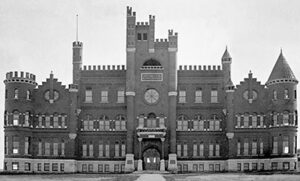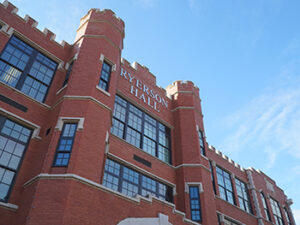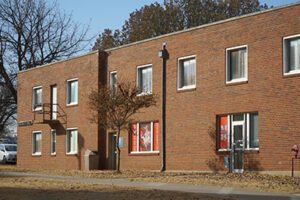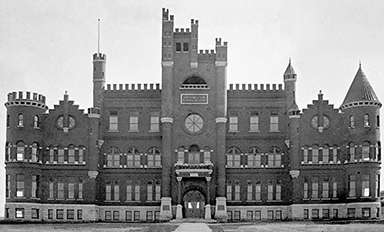By Dylan Whitley, Senior Reporter
How Northwestern’s buildings, degree programs have evolved
Once upon a time, there stood a castle upon the hill.
This may sound like the beginning to a fairytale, but this was not in some magical place far, far away. It was right here in Alva, and the castle was a building at Northwestern.
The university has a storied history and has seen many changes since it started in the late 1800s.
Educational programs have been added and cut, and buildings have been built up and torn down. It all started with the Castle on the Hill.
FIRST BUILDING
Northwestern’s Castle on the Hill was the school’s first building. Completed in 1899, a tall brick structure resembling the appearance of a castle stood in the spot where the Jesse Dunn building stands. It is named after Jesse Dunn, a man who settled around Alva in the land run and started a law practice here.
On March 1, 1935, around 2 a.m., the castle caught fire and was destroyed. It is an incident that is described in Wayne Lane’s book, “A Centennial History,” as “Northwestern’s greatest tragedy and its saddest hour.”

Flames had already spread rapidly out of control before they were discovered. Fire alarms awoke the town, which led many residents to campus to try to extinguish the raging blaze. The oiled wooden floors combined with the south wind made putting the fire out nearly impossible and caused a nearby house to also burn.
Three male students, who were staying in living quarters adjacent to the band room, were stuck on the roof with no way to get down. While fire trucks were still arriving at the scene, a student-athlete took one of the ladders off the truck to try to get the trapped men down safely.
But with the ladder being a little bit too short to reach, one of the students on the roof was lowered down by the other two so he could reach the ladder.
Once he made it down, the two men on the ground got a rope from Herod Hall’s stage and threw it to the two still on the roof, so they could tie it to a part of the wall and slide down to the ladder. All the students escaped with only minor cuts and bruises.
The fire destroyed most of the materials inside the building, including library shelves and books, art, historical documents, pianos and other instruments.
The cause of the fire is unknown. Some speculate that it was faulty wiring, while others believe it could have been a carelessly tossed lit cigarette butt.
MOVING FORWARD
Classes took one day off and then the following Monday were right back in session. Some classes that took place in the castle had to meet in other buildings around Alva.
Former Northwestern professor Dr. John Barton, who taught from 1966 to 1995 in the speech department, said the replacement building had to be made quickly and feasibly.
“I would have loved if they replaced the Castle on the Hill with another castle,” Barton said, “because if that Castle on the Hill was still here, there would be people coming from everywhere to see it.”
When he taught here, Barton worked in the Fine Arts Building, which is now Ryerson Hall. It was in need of an update during that time. Barton said fans were the only source of air conditioning in the building, which also had electrical problems. A problem he ran into was that he could not run a coffee maker and have the lights on at the same time.

In 1975, that building got a $437,400 update. Barton worked in the library annex that year while the work was being done. All the lighting and air conditioning were replaced as well as the walls and flooring. The first elevator on campus was installed in Fine Arts.
CHANGING PROGRAMS
Dr. Roger Hardaway, who has been a history professor at Northwestern for 33 years, said he has seen many changes throughout his teaching career.
Many programs have evolved or dissolved through time. Some of the earlier programs have gone away, such as the banjo and mandolin club in the early 1900s and the college wrestling team. Home economics courses no longer exist.
The Industrial Education building has many regular classrooms, but it used to be the home of industrial education courses that are no longer offered.
“That whole field is gone,” Hardaway said. “They used to have welding classes and carpentry classes in there, and that’s gone the way of the dinosaur.”
A few factors caused the programs to dissolve. The programs had low enrollment, and vocational technology centers began offering the courses.
The Science Building and the library were both built in 1963. Before then, the library was located where the natural history museum is now on the second floor of Jesse Dunn. Science classes used to take place in Carter Hall until the Science Building was approved and built. Barton remembers helping move the books from the old library in Jesse Dunn over to the one that had just been built.
DORMITORIES
The dormitory arrangements have changed from what they once were. In 1937, the university asked the state legislature to issue bonds for the construction of two dormitories. Northwestern was the only college in the state at the time that did not have any dorms for its students.
Vinson Hall and Shockley Hall were completed in 1939, with the women living in Shockley and the men living in Vinson. At the time, the room rate was $6 a month.

Shockley was named after Minnie Shockley, a long-time dean of women. Vinson was named after Augustus Grant Vinson, who was one of the six students in Northwestern’s first graduating class in 1900.
The Student Center was added in 1955. At the time, the building was the Wyatt Gymnasium, named after Frank Wyatt, who was the university’s first physical education director from 1906 to 1924. During its time, Wyatt Gym hosted many events.
One of those was in March 1937, when First Lady Eleanor Roosevelt traveled to Alva to give a speech about problems facing the nation’s youth. Converting the gym to the Student Center involved building a kitchen and a dining hall, game rooms, a bookstore, chapel and the addition of a second story, which became the ballroom.
Where the Wellness Center is today used to be the home of Northwestern football. Newby Field was named after Coach Winstar Newby, who was hired as the head coach of the football team in 1927. After the 1929 season, plans to sod the field, build new stands and get lighting for the field went into action and cost around $4,000, with Newby leading the push and even helping with some of the labor.
Plans to build a Wellness Center started in 1997 where Newby Field once was. It was completed in 2000 and had a swimming pool for students and the public to use. Before that, the swimming pool on campus was located where the commons area is located now in the Health and Sports Science building.
“It [Northwestern] has changed,” Hardaway said. “But like with everything else, you see it every day, so the changes just kind of slowly take place.”

